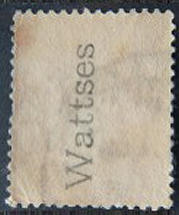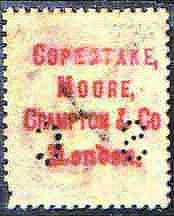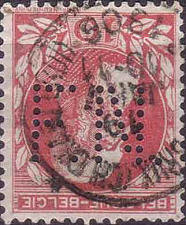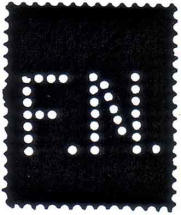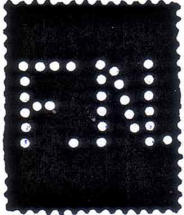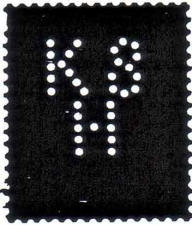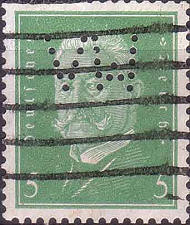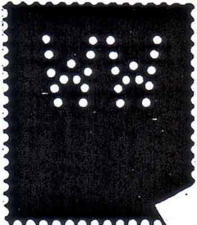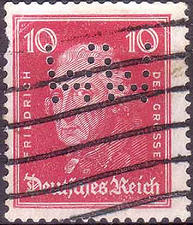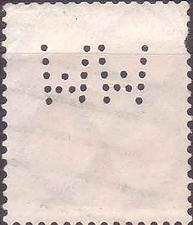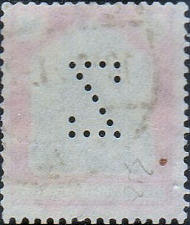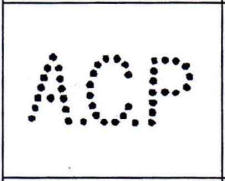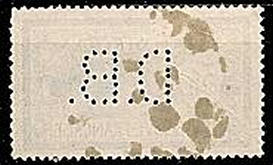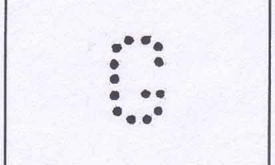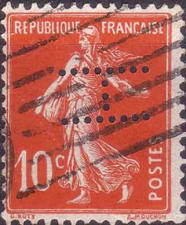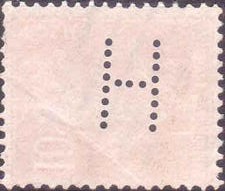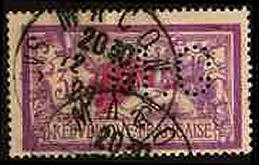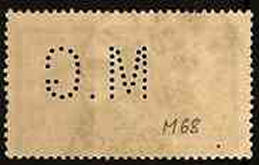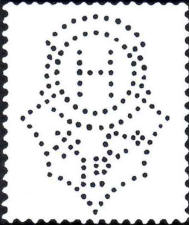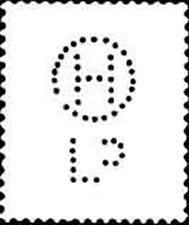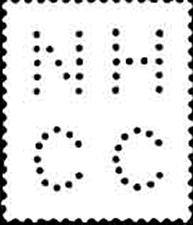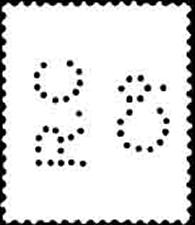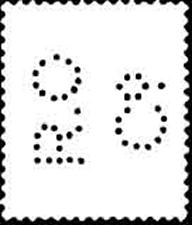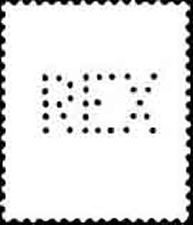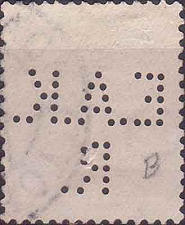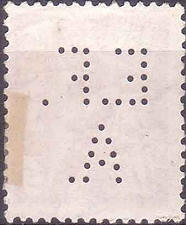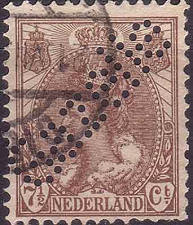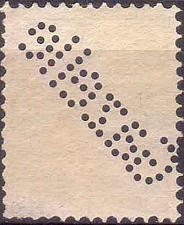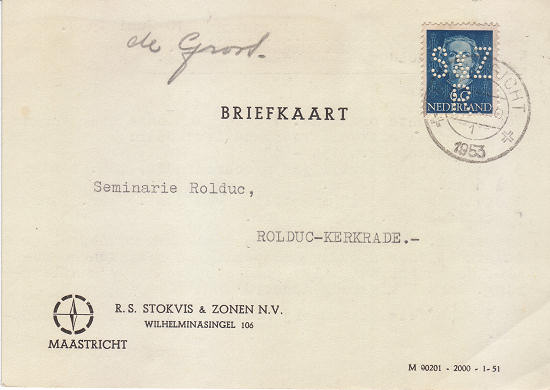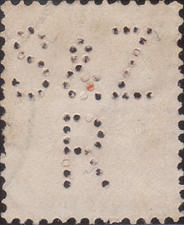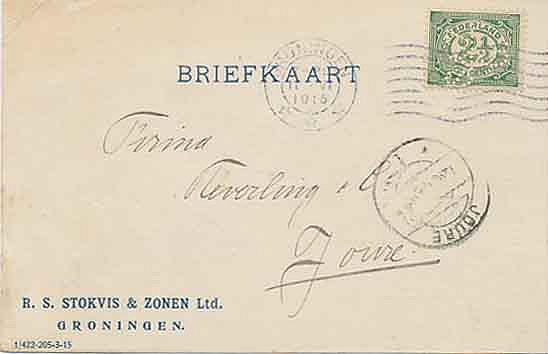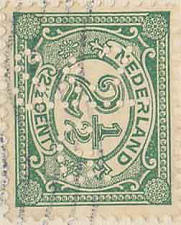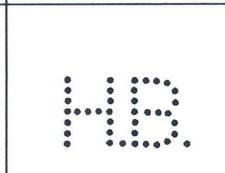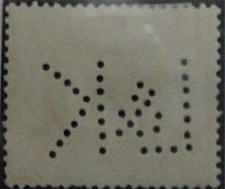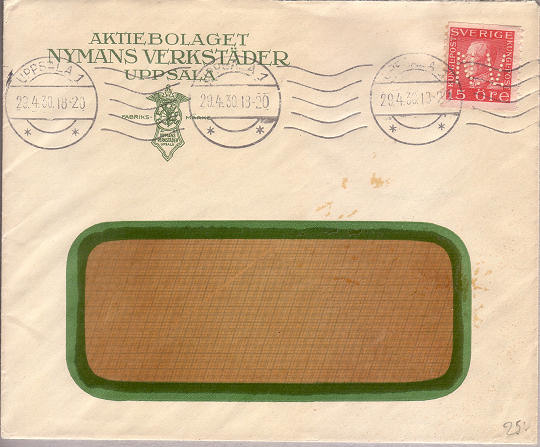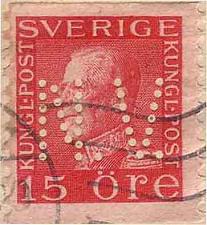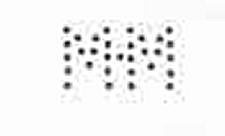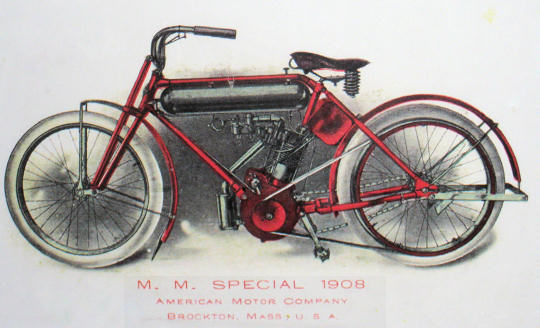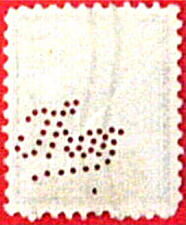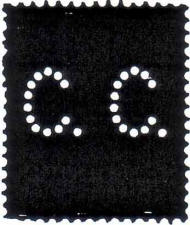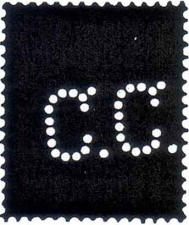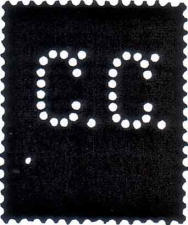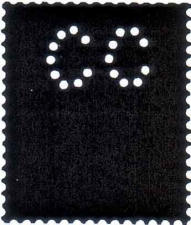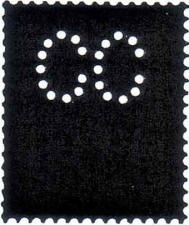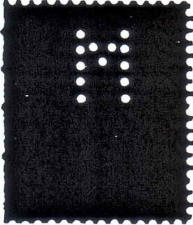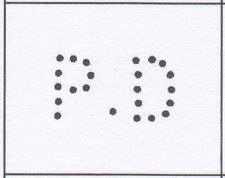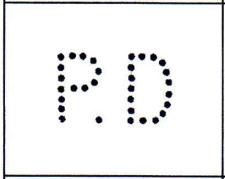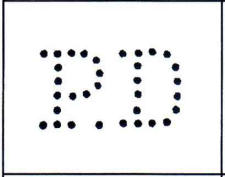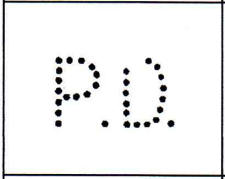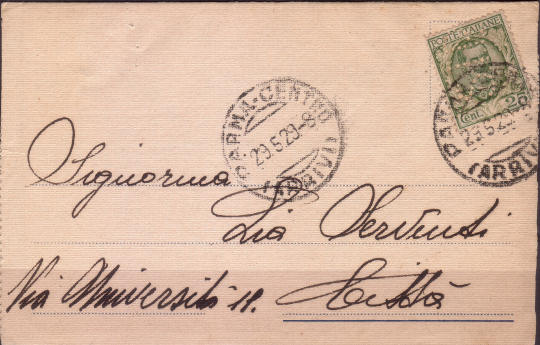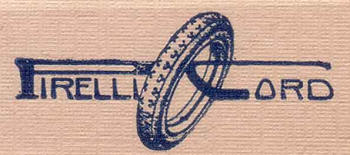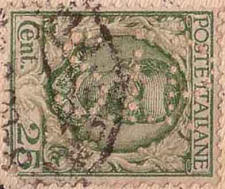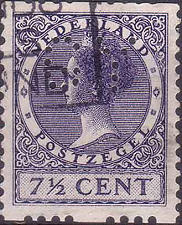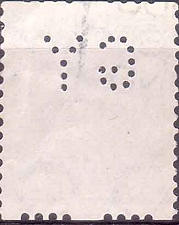Company perforations or PERFINS (2)Stamps with motorcycle images, that is what we collect. Preferably images of our own motorcycle. Sometimes we make a short excursion to letters with cancellation stamps. Even booklets with motorcycles on the cover, postcards with imprinted stamps and postal stationary are included in our collections. But stamps with holes in it!!!!! |
|||||||||||||||||||||||||||||||
|
|
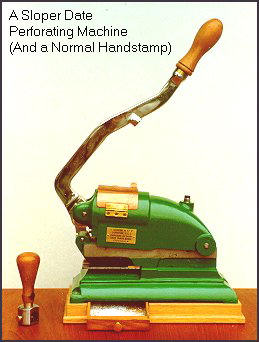 This was done with the perforator that had been patented by Joseph Sloper in 1858. With this machine holes could be made in paper in a pattern forming letters. First in the tax stamps that were already used and later, after the approval on March 13th 1868, also in post stamps. At the same time it was not allowed anymore for postal officers to accept stamps provided with perforations and exchange them for money. After calling it 'Pin perforated' or 'Perforated with company initials' for a long time, in 1943 the term Perfin, PERForated INitials (or INsignia), was introduced.
This was done with the perforator that had been patented by Joseph Sloper in 1858. With this machine holes could be made in paper in a pattern forming letters. First in the tax stamps that were already used and later, after the approval on March 13th 1868, also in post stamps. At the same time it was not allowed anymore for postal officers to accept stamps provided with perforations and exchange them for money. After calling it 'Pin perforated' or 'Perforated with company initials' for a long time, in 1943 the term Perfin, PERForated INitials (or INsignia), was introduced.
So, perfins are deliberately made holes put up in the pattern of initials, logo's or images, to prevent theft of stamps by employees.
Over the course of time thousands different perfins have been made, and they have been used in almost all countries over the world. Our, unfortunately too early passed away, MFN member
Harrie Rutgers has in the past successfully participated in expositions with his collection Cuban Perfins. But this didn't contain any motorcycle related items.
How many of them exist? I don't know, but after the start made by Hans in Newsletter 23 I still want to show the result of my quest here. First the perfins of motorcycle manufacturers, ordered by country, next perfins of tyre manufacturers etcetera.
Of each perfin the following information (as far as known) is given: perforation - company (period that the perfin has been in use).
Motorcycle manufacturers:
Belgium:
F.N. - Fabrique National d'Armes de Guerre, Luik (unknown).
Has, next to a perfin with 34 holes (in total), also used perfins with 30 and 33 holes.
|
|
|
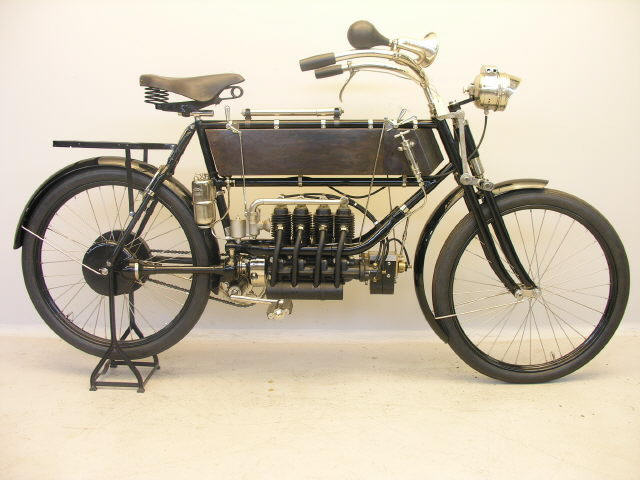
FN Type A - 363cc 4-cilinder 1905
Germany:
KSH - Knopf Sohne, Halberstadt (1923-1941).
Trading company with various articles, amongst which also for automobile and motorcycle riders.
VW - Victoria-Werke, Nürnberg (1923-1937).
Founded as bicycle manufaturer and in 1901 started producing motorcycles.
During the use of the perforator pins tend to break off sometimes, resulting in incomplete perfins as can be seen on the image on the right underneath the V.
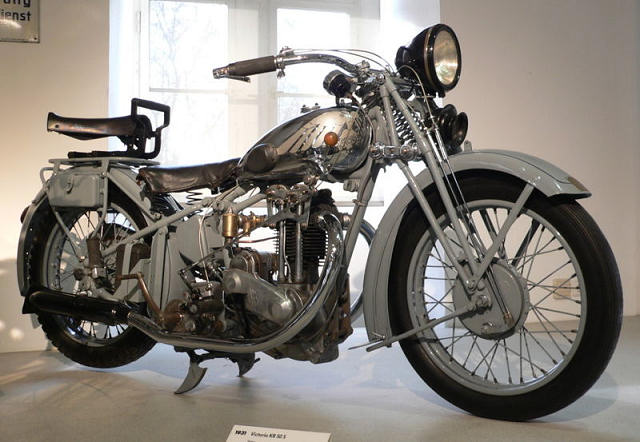
Victoria KR50S - 500cc 1931
WW - Wanderer-Werke, Chemnitz (1913-1927).
Started as 'Chemnitzer Velociped-Depot Winklhofer & Jaenicke' the production of motorcycles started in 1902. Perfin type 1 has been used from 1913 up to 1924 and after that type 2 from 1925 to 1927.
|
|
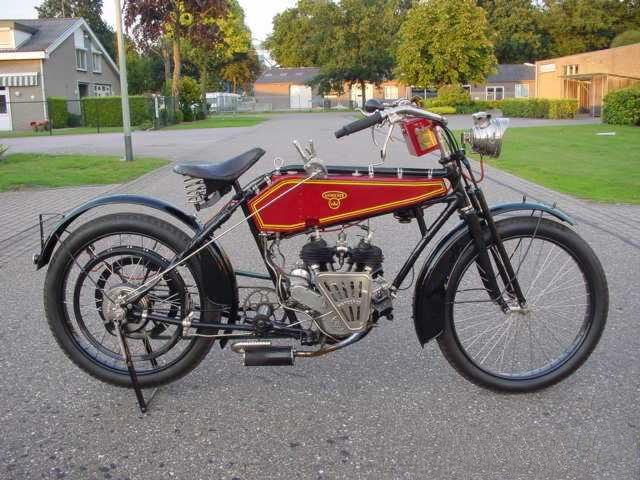
Wanderer V-twin - 500cc 1915
Z - Zündapp, Nürnberg (1923-1927).
Founded as 'Zünder und Apparatenbau GmbH', the K249 was produced in the period that the perfin was in use.
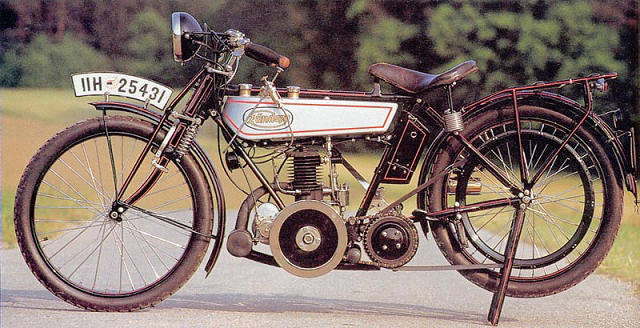
Zündapp 250cc, around 1925
France:
A.C.P. - SA Automobiles et Cycles Peugeot, Paris (1921 -1926).
During the 20-ies the bicycle and motorcycle department were separated from the automobiles.
D.B. - De Dion-Bouton, Paris (1907-1938).
Although the production of the tricycle was already stopped in 1905, the factory still delivered its famous engine for many years to various motorcycle manufacturers.
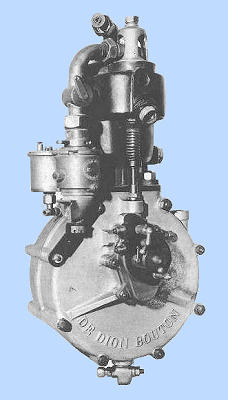
A De Dion Bouton watercooled 1-cilinder
G - Cycles et motocycles 'Alcyon', Paris (motorcycle brands Alcyon, Olympique and later Diamant) (unknown).
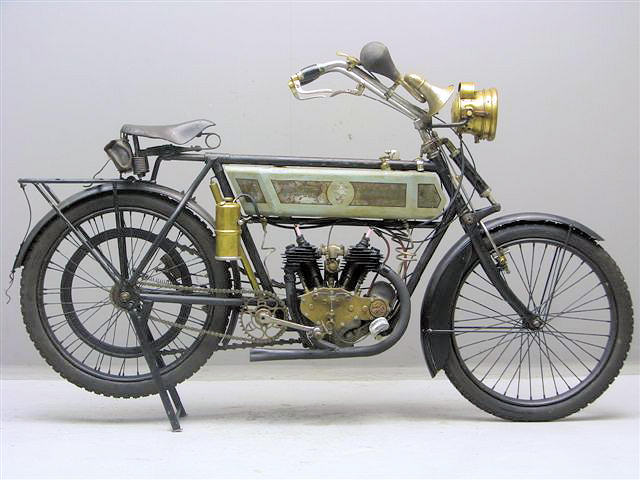
Alcyon V-twin - 350cc 1914
H - Cycle la Française Marque Diamant, Paris (1914-1927).
Probably started in 1902 with production of motorcycles. In 1923 taken over by Alcyon.
M.G - Monet et Goyon, Macon (1930-1935).
Has built motorcycles from 1917 up to 1957.

Stamp booklet with advertisement for Monet & Goyon motorcycles
T&C. - Terrot et Cie, Dijon (1902-1911).
Although the production of Terrot, started in 1901, went on until 1960, the use of perfins has stopped in 1911.
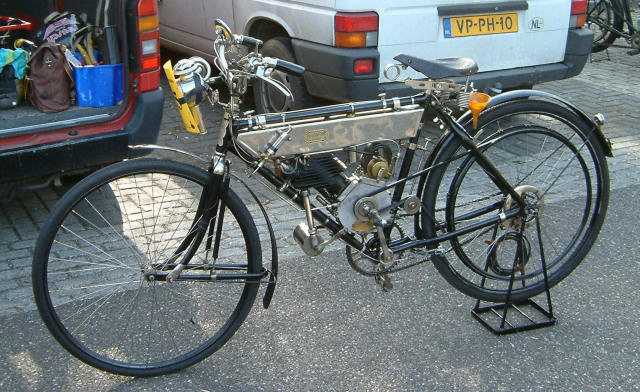
Terrot Model A - ca. 1910
Great Brittain:
BSA - Birmingham Small Arms, Birmingham (1930-1939).
Influenced by the Krim war, founded to produce machine guns. Started in 1903 to make motorcycles.
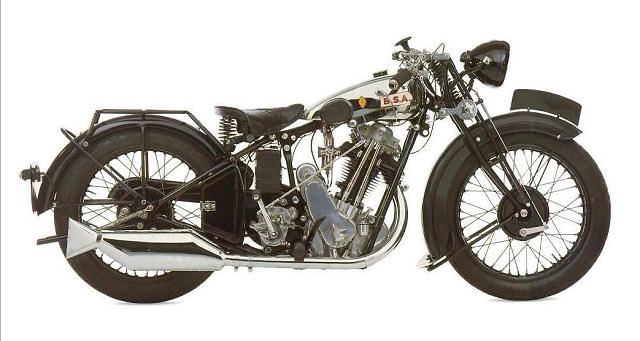
BSA S31 Sloper - 500cc 1930
ECC - Enfield Cycle Co, Enfield (1895-1939).
After the original start with the production of needles an fishing hooks, the bicycle manufacturing department in Enfield was started after the take-over by Eadie. There also the motorcycles were built. Over the course of time 3 different perfins have been used.
Type 1 from 1895 to 1935, type 2 from 1905 up to 1915 and type 3 from 1915 up to 1939.
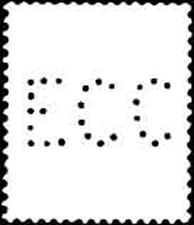
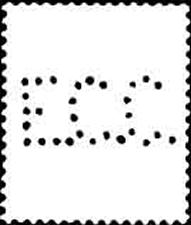
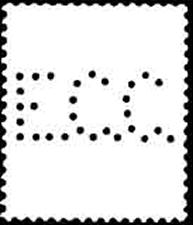
Type 1 Type 2 Type 3
In contradiction to the Royal Enfield motorcycles the perfins have been made very poorly.
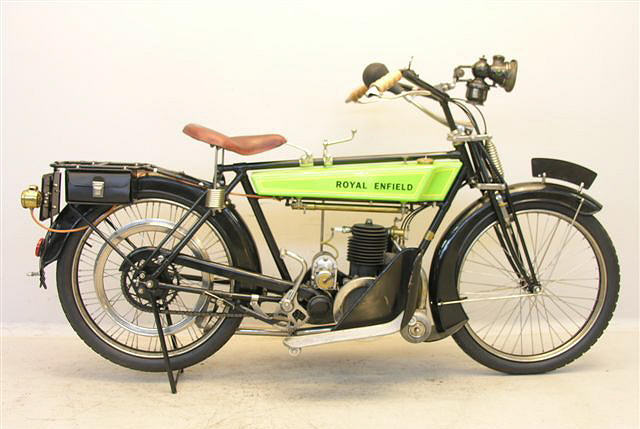
Royal Enfield RE201 - 225cc 1923
HL - Humber & Co, Coventry (1890-1904).
Started in Sheffield, after that via Wolverhampton to Coventry. After the bankruptcy in 1900 continued under the name Humber Ltd. The first perfin was an image of a frame tag. Used from 1890 to 1895, with 130 holes it is the largest known perfin. The second has been used from 1902 up to 1904.
With so many pins the chance of breaking off was very large (see arrow).
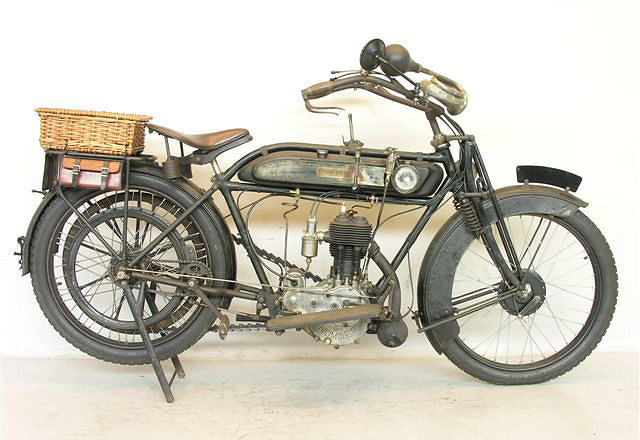
Humber 3-speed - 500cc 1914
NHCC - New Hudson Cycle Co, Birmingham (1896-1936).
Founded as Hudson, Edmonds & Co a namechange followed in 1898, and in 1902 the first motorcycle. No success, and not before 1910 production was continued until a second, definitive stop in 1932.
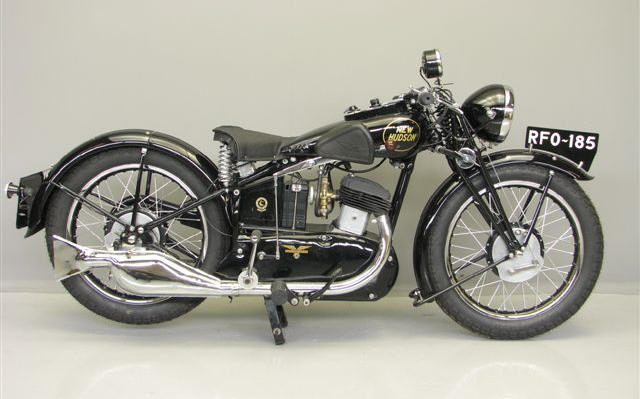
New Hudson Model 34 - 350cc 1932
RCCo - Raleigh Cycle Co, Nottingham (1918-1925).
In Raleigh Street in Nottingham the bicycle factory was founded, and in 1899 production of motorcycles was started. The second perfin, in which the first C has been closed, originated from 1925.
REX - Rex Motor (Manufacturing) Company, Coventry (1905-1910).
Both the first named and the Motor Car en Motor Cycle Makers have been founded in 1902. From 1903 Rex concentrated on motorized bicycles. In 1911, after the discontinuation of the use of perfins, the focus was on motorcycles.
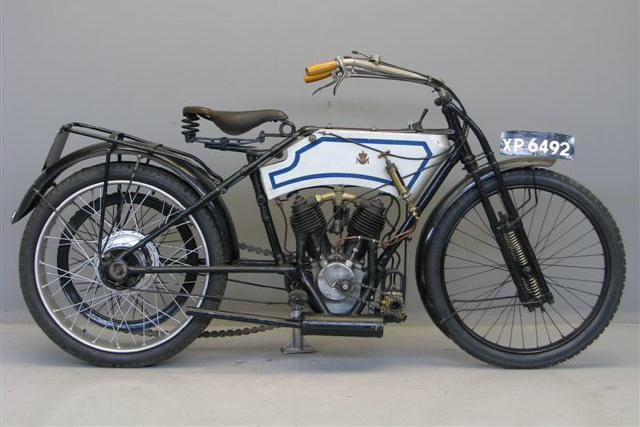
Rex 5 1/2 HP - 650cc 1907
Netherlands:
E.A.K.R. - Ernst August Kestein Rotterdam, Rotterdam (unknown).
During its existence Kestein has produced motorcycles only during a short period, 1935-1936. A clear date stamp on the post stamp indicates whether it is from the right period.
EFA - Eysink Fabrieken Amersfoort, Amersfoort (1925-1944).
Started in 1901 with the construction of motorcycles, the factory has standed until the first oil crisis in 1956.

Eysink "Alps chaser" - 350 cc 1938
Gazelle - Gazelle Rijwielfabriek (bicyle factory), formerly Arentsen & Kolling, Dieren (1920-1928).
This factory, founded by Willem Kolling, was the only motorcycle manufacturer using a diagonal perfin.
S&Z R - Stokvis & Zonen Rotterdam, Rotterdam (unknown).
Trading company from Rotterdam, especially known als importer of the Puch mopeds in the years 60 and 70. But also licensed producer of the Solex and Dutch moped brands like Amstel and Rap. Stokvis had several sales offices, like in Amsterdam and Groningen, that also used own perfins.
|
|
|
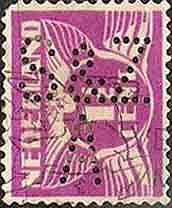
Stokvis Amsterdam
Austria:
H.B. - Bock & Hollender, Wenen (unknown).
Founded in 1898 for the production of cars. From 1905 to 1911 also motorcycles have been produced. After take-over by WAM in 1911 they stopped making motorcycles.
PUCH - Puch Werke AG, Graz (unknown).
Founded in 1899 by Janez Puh (Johann Puch), first the bicycle factory Styria and in 1901 a new factory for motorcycles.
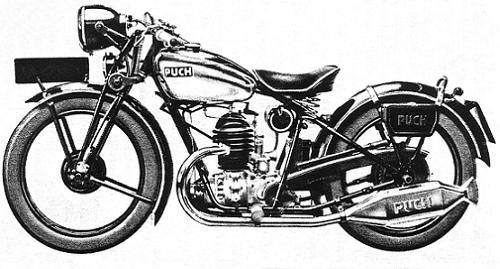
Puch S4 ca. 1935
Tsjecho-Slowakia:
L&K - Laurin & Klement, Mlade Boleslav, Bohemen, former Austria-Hungary now Tsjech Republic (unknown).
Started in 1899 with building motorcycles, but already in 1908 changed over to 4-wheelers. It is not unlikely that after that some motorcycles have still been built.
Sweden:
NV - Nymans Verkstäder, Uppsala (unknown).
Founded in 183 by Anders Nymans, started in 1903 with motorized bicycles, and in 1926 with motorcycles, the NV Model 249. First built by Svensk Motorindu in Örkelljunga, and from 1927 by NV itself.
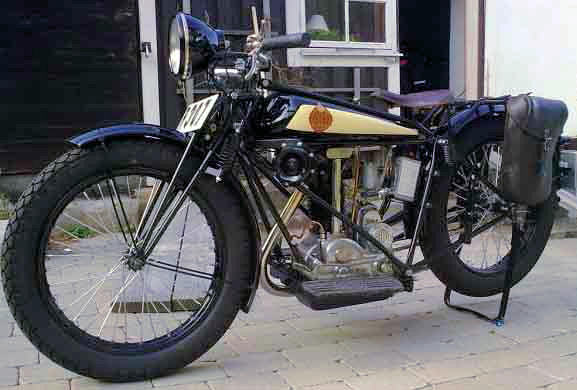
Nymans Verkstäder motorcycle
USA:
MM - American Motor Co, Brocton Massachusetts (unknown).
Thor - Thor Moto Cycle and Bicycle company, Aurora Illinois (unknown).
In 1903 Aurora founded this factory, to build a motorcycle that had been developed by Henderson.
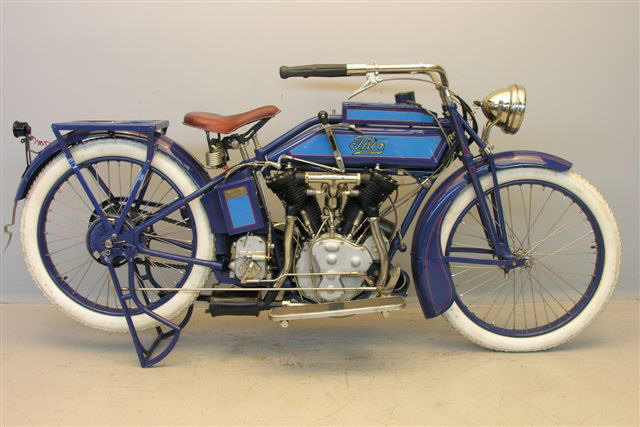
Thor - 1000cc 1916
Tyre manufacturers:
Germany:
C.C. - Continental Caoutchouc und Gutta Percha Compagnie, Hannover (1902-1954).
Founded in 1871 as producer of rubber, and now the 5th tyre manufacturer in the world. Continental has used several perfins during many years.
|
|
|
||
|
|
|||
M - Metzeler-Pneumatic, München (1912-1921).
Founded in 1863 by Robert Metzeler as trading company in rubber. The big break-through was due to plane tyres, and later car and motorcycle tyres, that were already patented in Switserland in 1898.
France:
M - Michelin, Clermont-Ferrand (1920-1930).
Founded by the brothers André and Édouard Michelin. In 1891 an Englishman came to their factory with a flat tyre. The tyre had been glued to the rim and gave a lot of trouble, which lead the brothers to the idea of detachable tyres. Now Michelin is the biggest but one producer of car and motorcycle tyres.
P.D. - Pneumatiques Dunlop, Paris (1911-1954).
The Dunlop tyre has been developed by veterinary surgeon John Boyd Dunlop for his son's bicycle in 1888. Short after that he started a factory that opened branches in several countries. The branch in Paris has used various perfins. It looks like perfin type 4 is missing a pin.
|
|
|
|
Italy:
S.I.P. - Società Italiana Pirelli, Milaan (unknown).
Founded in 1872 as Pirelli & C. by Giovanni Pirelli, and in the 30-ies renamed into Soc Italiana Pirelli. First a small rubber factory, but already soon they produced bicycle, motor and car tyres.
Netherlands:
GY - Goodyear Tire and Rubber Company, Goodyear (unknown).
Frank Seiberling named his company in 1898 after the inventor of vulcanised rubber: Charles Goodyear. Now the company is the biggest producer of tyres with branches all over the world, also in the Netherlands.
Great Brittain:
DRC - Dunlop Rubber Company (unknown).
No image.
DP/TCo - Dunlop Pneumatic / Tyre Company (unknown).
No image.
K/LG - KLG Sparking Plugs Ltd, Putneyvale (unknown).
No image.
I don't have the illusion that this is all, but there are for sure much more perfins that belong to our theme than I expected in first instance. The search is continued, after new, unknown perfins and after specimens to add to my collection. When there are people who know other perfins that are not in the list, I would be very glad to hear to complete my list.
Nico Helling
For more info about perfins (in Dutch): www.perfinclub.nl
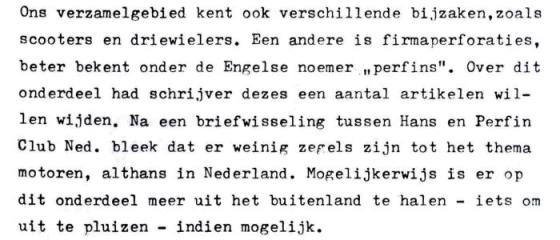
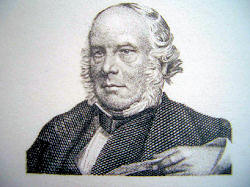 After Rowland Hill, a teacher, started working for the English Post, he discovered that the postal service was 'expensive' and that most of the costs concerned the reception and delivery of the post. In his proposal from 1837 he suggested to let the sender pay the postal delivery in advance. Prove for the prepayment had to be by using prepaid letters (letter with imprinted value) or by pasting self-adhesive stamps.
After Rowland Hill, a teacher, started working for the English Post, he discovered that the postal service was 'expensive' and that most of the costs concerned the reception and delivery of the post. In his proposal from 1837 he suggested to let the sender pay the postal delivery in advance. Prove for the prepayment had to be by using prepaid letters (letter with imprinted value) or by pasting self-adhesive stamps.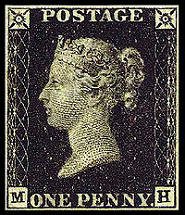 Further the many, complex tarifs had to be replaced by a uniform tarif: for all letters with inland destination up to 1 ounce (28.34 gramms) 1 penny. After tihis proposal was accepted in 1840 the first stamp appeared: the Penny Black.
Further the many, complex tarifs had to be replaced by a uniform tarif: for all letters with inland destination up to 1 ounce (28.34 gramms) 1 penny. After tihis proposal was accepted in 1840 the first stamp appeared: the Penny Black.